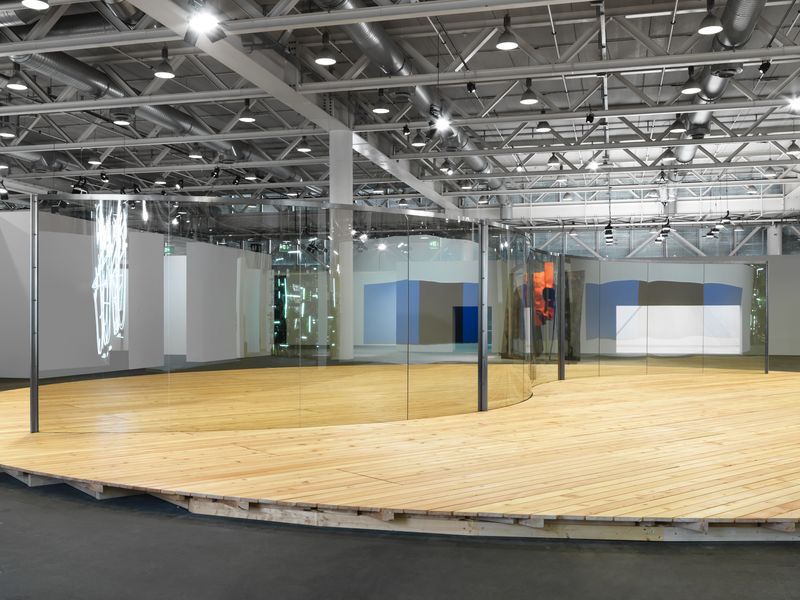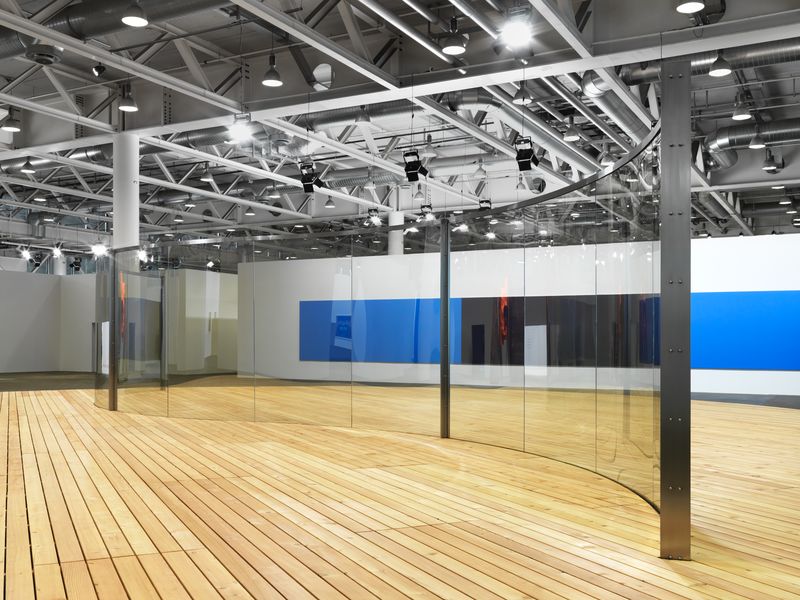Dan Graham at Unlimited

Dan Graham, S-Curve for St. Gallen, 2001. Installation view, Unlimited, Art Basel, Basel, 2018 © Dan Graham
Dan Graham at Unlimited
25 April 2018
For fifty years, Dan Graham has traced the symbiosis between architectural environments and their inhabitants. With a practice that encompasses curating, writing, performance, installation, video, photography, and architecture, his analytical bent first came to attention with Homes for America (1966 – 1967), a sequence of photos of suburban development in New Jersey, accompanied by a text charting the economics of land use and the obsolescence of architecture and craftsmanship. Graham’s critical engagement manifests most alluringly in the glass and mirrored pavilions, which he has designed since the late 1970s and which have been realized in sites all over the world.
Blurring the line between art and architecture, Graham’s pavilions are comprised of steel, mirror, and glass to create diverse optical effects. Created as hybrids, they operate as quasi-functional spaces and art installations. Rigorously conceptual, uniquely beautiful, and avowedly public, the pavilions exhibit a deliberate disorientation and playfulness that Graham encourages.
'S-Curve for St. Gallen' (2001) is composed of two-way mirror glass and steel, the transparent but reflective walls produce a distorted reflection, meaning the viewer becomes involved in the voyeuristic act of seeing oneself reflected, while at the same time watching others – playing with the physical reality and the reflection, and creating light-hearted situations out of a surveillance culture.

Dan Graham, S-Curve for St. Gallen, 2001. Installation view, Unlimited, Art Basel, Basel, 2018 © Dan Graham
Poised between sculpture and architecture, 'S-Curve for St. Gallen' gleans a sparseness from 1960s Minimalism, redolent of Graham’s emergence in New York in the 1960s alongside Sol LeWitt, Donald Judd, and Robert Smithson. The piece is also rooted in everyday urban life and activity, a hybrid between sculpture and architecture.
Graham considers his pavilions to have sources in architecture and urban design; the skyscraper and two-way mirror corporate office buildings; eighteenth century English landscape design; the folly and the picturesque; elliptical neo-Baroque space and the Rococo.
Through his choice of shape and material Graham blurs perceptions in 'S-Curve for St. Gallen' – outside and inside, focus and dissolution, the virtual and the real. Graham has described his work and its various manifestations as ‘geometric forms inhabited and activated by the presence of the viewer, [producing] a sense of uneasiness and psychological alienation through a constant play between feelings of inclusion and exclusion.’
'S-Curve for St. Gallen' alongside Graham’s other multifaceted pavilions draw attention to architecture as an instrument of expression, a psychological stronghold, a marker of social change, and a prism through which we view others and ourselves.

Dan Graham, S-Curve for St. Gallen, 2001. Installation view, St. Gallen, Switzerland, 2001 © Dan Graham. Photo: A. Burger

Dan Graham, S-Curve for St. Gallen, 2001. Installation view, St. Gallen, Switzerland, 2001 © Dan Graham. Photo: A. Burger
Related News
1 / 5




